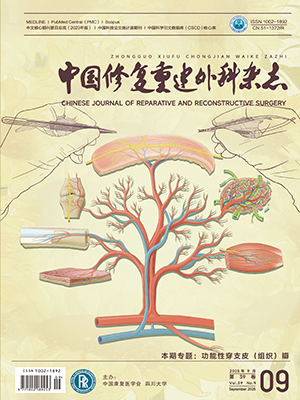| 1. |
Miyazaki T, Ishikawa K, Shirosaki Y, et al. Organic-inorganic composites designed for biomedical applications. Biol Pharm Bull, 2013, 36(11):1670-1675.
|
| 2. |
Jung UW, Lee JS, Lee G, et al. Role of collagen membrane in lateral onlay grafting with bovine hydroxyapatite incorporated with collagen matrix in dogs. J Periodontal Implant Sci, 2013, 43(2):64-71.
|
| 3. |
Félix Lanao RP, Jonker AM, Wolke JG, et al. Physicochemical properties and applications of poly (lactic-co-glycolic acid) for use in bone regeneration. Tissue Eng Part B Rev, 2013, 19(4):380-390.
|
| 4. |
Delabarde C, Plummer CJ, Bourban PE, et al. Biodegradable polylactide/hydroxyapatite nanocomposite foam scaffolds for bone tissue engineering applications. J Mater Sci Mater Med, 2012, 23(6):1371-1385.
|
| 5. |
张育敏, 李宝兴, 李冀, 等. 聚乳酸-骨基质明胶多孔复合材料制备及骨诱导活性研究. 中国修复重建外科杂志, 2007, 21(2):135-139.
|
| 6. |
中华人民共和国国家标准 医疗器械生物学评价第5部分:细胞毒性试验:体外法. 北京:中国标准出版社, 1997.
|
| 7. |
卫生部药政管理局. 生物材料和医疗器材生物学评价技术要求. 北京:中国标准出版社, 1997:1-44.
|
| 8. |
郝和平, 卜长生, 刘秦玉, 等. 医疗器械生物学评价标准实施指南. 北京:中国标准出版社, 2002.
|
| 9. |
Bruinink A, Luginbuehl R. Evaluation of biocompatibility using in vitro methods:interpretation and limitations. Adv Biochem Eng Biotechnol, 2012, 126:117-152.
|
| 10. |
Mangala MG, Chandra SM, Bhavle RM. To evaluate the biocompatibility of the Indian Portland cement with potential for use in dentistry:An animal study. J Conserv Dent, 2015, 18(6):440-444.
|
| 11. |
Di Virgilio AL, Arnal PM, Maisuls I. Biocompatibility of core@shell particles:cytotoxicity and genotoxicity in human osteosarcoma cells of colloidal silica spheres coated with crystalline or amorphous zirconia. Mutat Res Genet Toxicol Environ Mutagen, 2014, 770:85-94.
|
| 12. |
黄金龙, 夏虹, 李丽华, 等. 异种骨与成骨细胞体外生物相容性研究. 中国矫形外科杂志, 2014, 22(2):158-162.
|
| 13. |
Trang NT, Chinhl NT, Thanh DT, et al. Investigating the properties and hydrolysis ability of poly-lactic acid/chitosan nanocomposites using polycaprolactone. J Nanosci Nanotechnol, 2015, 15(12):9585-9590.
|
| 14. |
Manavitehrani I, Fathi A, Wang Y, et al. Reinforced poly (propylene carbonate) composite with enhanced and tunable characteristics, an alternative for poly (lactic acid). ACS Appl Mater Interfaces, 2015, 7(40):22421-22430.
|
| 15. |
Russias J, Saiz E, Nalla RK, et al. Fabrication and mechanical properties of PLA/HA composites:A study of in vitro degradation. Mater Sci Eng C Biomim Supramol Syst, 2006, 26(8):1289-1295.
|
| 16. |
Persson M, Lorite GS, Kokkonen HE, et al. Effect of bioactive extruded PLA/HA composite films on focal adhesion formation of preosteoblastic cells. Colloids Surf B Biointerfaces, 2014, 1(121):409-416.
|
| 17. |
Ullm S, Krüger A, Tondera C, et al. Biocompatibility and inflammatory response in vitro and in vivo to gelatin-based biomaterials with tailorable elastic properties. Biomaterials, 2014, 35(37):9755-9766.
|
| 18. |
Valiense H, Barreto M, Resende RF, et al. In vitro and in vivo evaluation of strontium-containing nanostructured carbonated hydroxyapatite/sodium alginate for sinus lift in rabbits. J Biomed Mater Res B Appl Biomater, 2016, 104(2):274-282.
|
| 19. |
连芩, 庄佩, 李常海, 等. 3-D打印双管道聚乳酸/β-磷酸三钙生物陶瓷复合材料支架的力学性能研究. 中国修复重建外科杂志, 2014, 28(3):309-313.
|
| 20. |
Lopes MS, Jardini AL. Poly (lactic acid) production for tissue engineering application. Procedia Engineering, 2012, 42:1402-1413.
|
| 21. |
Włodarski P, Galus R, Brodzikowska A, et al. Osteogenic efficiency of demineralized and lyophylized xenogeneic bone and syngeneic dentine implants in mice. Folia Biol (Krakow), 2013, 61(1-2):25-29.
|
| 22. |
Bigham AS, Shadkhast M, Bigham Sadegh A, et al. Evaluation of osteoinduction properties of the demineralized bovine foetal growth plate powder as a new xenogenic biomaterial in rat. Res Vet Sci, 2011, 91(2):306-310.
|




